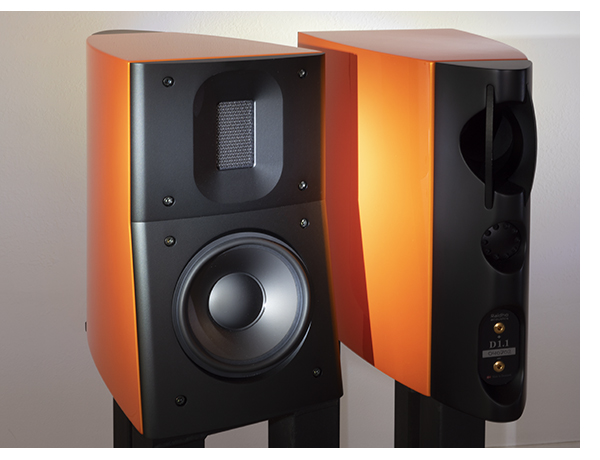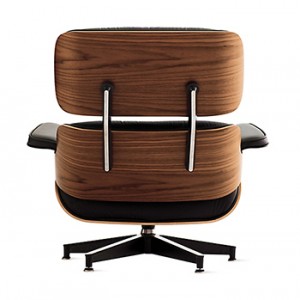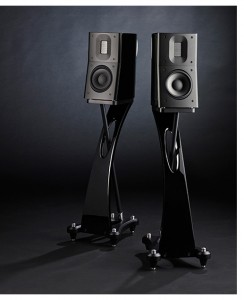The Raidho D1.1 One big step for a small speaker
By Jeff Dorgay The opening organ riff in the Who’s “Eminence Front” permeates my listening room. Diffuse, yet locked down slightly off the center of the soundstage as Pete Townshends guitar comes up out of nowhere and the track builds in intensity before his lead vocal enters the mix. These small monitors do the near impossible – they play loud, like a pair of big speakers.
The opening organ riff in the Who’s “Eminence Front” permeates my listening room. Diffuse, yet locked down slightly off the center of the soundstage as Pete Townshends guitar comes up out of nowhere and the track builds in intensity before his lead vocal enters the mix. These small monitors do the near impossible – they play loud, like a pair of big speakers.
Pushing the volume until my Pass INT-60 flattens out, the soundstage from the D1.1s just keeps getting bigger. Talk about good first impressions. Moving on to Keith Richards, “Wicked as it Seems” delivers similar dynamic excellence. Hours later, my ears are buzzing from listening to music so damn loud. Yet these little speakers offer such an undistorted, unfatiguing look at my favorite tunes, it’s easy to go past the danger zone.
I need to confess a hard-core reviewer bias right away. I really like Raidho speakers. A lot. A lot, a lot. I’ve been using a pair of their entry level X-1s in system two for some time now and they deliver such an incredible amount of musical detail, combined with a level of smoothness and dynamics that I’ve never heard from a ribbon tweeter, it’s tough not to be smitten – especially for someone that really enjoys the transparency of an ESL. The Raidho driver is even faster, and they incorporate this tweeter in every speaker they make, so if you discover that you like the Raidho sound as much as I do, you just get more of it as you go up the line. Think of it like drinking Macallan’s 12, 18, 24, or 60. More refinement costs more…
While all Raidho speakers share a common tweeter, the X series utilizes Raidho’s ceramic coned woofers, and the D series uses their diamond cones. The diamond composite in this driver is deposited at high voltage to create a cone that has no breakup anywhere near the audible range, making for an incredibly distortion free presentation. Unlike speakers built around the Accuton drivers, the Raidho driver takes this much further, offering much greater dynamic punch. No matter what your favorite type of music, these are not audiophile speakers, limited to solo vocalists and string quartets. They deliver massive dynamic contrasts when called upon.
$25k/pair vs. $6k/pair
A number of audiophile buddies observing the slightly larger D1.1 next to the X-1 all gave me the same look – how much more for these smallish speakers? It’s not a misprint, a pair of D1.1s will set you back $25k. A little more if you want the custom finish you see on our test pair.
Why you might want to consider going up the range is the level of refinement these speakers offer. You could argue that my $20k/pair Focal Sopra no.3s in room one arefull range floorstanding speakers for less money. That’s a valid argument, and smitten as I am with these little Raidhos, my Sopras aren’t showing up on Audiogon anytime soon. Yet, after hearing Raidhos in a number of different show rooms, dealers and my own room, there is something special here.
Where the entry level Raidho X-1 remains a fantastic speaker, and compared to a lot of small $4-$6k monitors I’ve experienced, a top value, the D1.1s are in an entirely different league. The D1.1s can play much louder, much cleaner and are truly world class. If you’ve ever met a feisty small dog and had their owner say, “He thinks he’s a big dog. He doesn’t know he’s in a small dog body,” that sums up the performance and attitude of the D1.1.
Yes, you will have to get a subwoofer or pair of subwoofers to get true full range performance with the D1.1s, but from about 50hz up, they rival anything I’ve experienced at any price. In a small room you may not even need the sub, depending on your musical requirements. I was more than impressed with the quality of the bass response in our smaller, 13 x 15 foot room.
Critical set up
While the D1.1s are nowhere near as fussy as some mega speakers I’ve set up, the one aspect that is critical when setting up any Raidho speaker is getting the rake angle correct. The ribbon does not have as much horizontal dispersion as some other speakers, so if you lean Raidhos back too far, the high frequencies will appear dull and diffused, along with a loss of image precision. A similar thing happens tipping them too far forward, but now additional image smear from floor reflections will muddle the mix even more.
The good news is that this limited horizontal dispersion makes the Raidhos a lot easier to integrate in a room than many others, because there’s not a ton of downward firing energy from said tweeter to interfere with the presentation.
As with any other speaker, use whatever method you choose to get the best low/mid frequency integration in the room and then slowly adjust the rake angle a couple of degrees at a time. Lift your head above and below the axis you are set, to figure out where you need to go for the optimum sound. Finally, experiment a bit with toe in for the last bit of fine tuning.
With a claimed impedance of 6 ohms and a fairly low sensitivity of 85db/1 watt, these compact monitors are fairly power hungry. The Raidho website suggests a minimum of 50 watts per channel, but “good results with low power tube amplifiers are possible.” While I had decent results with our PrimaLuna DiaLogue HP Premium integrated amplifier (60wpc with EL34s) the Raidhos did a lot better with the KT150s installed (92wpc) and are pure heaven with the new PrimaLuna 140wpc EVO 400 monoblocks.
At the end of the day, my personal favorite was still pairing these amplifiers with solid-state amplification, and my experience with the Pass XA200.8s, the new Bryston 28B cubed, and the Luxman C900-n power amplifiers all deliver the most engaging performances with the small Raidhos. The big, high current amplifiers all produce a broader sense of dynamic scale, along with better bass control and extension than their tube counterparts. The few additional molecules of three dimensional space that the tube amplifiers could muster was not worth the added punch of the solid state amps.
A particularly nice combination was the pairing of the Nagra Classic Preamplifer and the Bryston amplifiers. These 1000 watt per channel amplifiers have grip in spades, and the ever so slightly warm presentation of the Nagra offers the best of both worlds. Of course, you will have to find your own nirvana with the D1.1s, but don’t scrimp on any other part of your system if you want them to give their best performance.
Returning to the listening chair
Once you have your D1.1s optimized to your taste and ability, expect a huge, presentation that will fool you time and time again that there really are a pair of floor standers lurking in your listening room.
 Additionally, the tremendous amount of speed, and the coherent integration between woofer and tweeter will keep even the most feverish panel lovers happy. Acoustic instruments are reproduced with a stunning degree of realism, and heavily multi-tracked selections unravel with ease in front of you. As I may have mentioned before, but even more with the D1.1s, their setup is much like fine tuning the VTA on a premium phono cartridge. When it’s right, the presentation is almost limitless, and when it’s not, things are flat.
Additionally, the tremendous amount of speed, and the coherent integration between woofer and tweeter will keep even the most feverish panel lovers happy. Acoustic instruments are reproduced with a stunning degree of realism, and heavily multi-tracked selections unravel with ease in front of you. As I may have mentioned before, but even more with the D1.1s, their setup is much like fine tuning the VTA on a premium phono cartridge. When it’s right, the presentation is almost limitless, and when it’s not, things are flat.
Most impressive about the D1.1s, as with my reference X1s is their ability to do a great job on less than pristine musical selections. These are musical speakers first, not audiophile speakers, limited to a few perfect tracks. Thanks to the incredibly low distortion in the Raidhos, these are speakers you can listen to all day long with no fatigue.
As mentioned earlier, the bass that these speakers can generate is of extremely high quality, and extends quite low, lower than the 50hz spec might suggest. Tracking through a long play list of hip hop, electronica, and classic rock tracks with plenty of low bass output was indeed satisfying, though with the Bryston amplifier’s 1000 watts per channel on tap, I did have to be careful not to bottom those little woofer cones!
 They are also available in black…
They are also available in black…
Musically engaging as the D1.1s are, if you take enough time to really examine them closely, you will see just how beautiful they are built. The finish is luxury squared, as is the fine points of cabinet assembly. Joints are invisible, corners are perfectly executed and the gaps between the front face and the rest of the cabinet are meticulously optimized. The D1.1s look the part as well as sounding it.
Those wanting a compact, yet high performance monitor should consider the Raidho D1.1 at the top of their list. They are certainly at the top of ours. Highly recommended.
The Raidho D1.1
$25,000/pair
Peripherals
Cartridge Koetsu Onyx Platinum, My Sonic Lab Ultra Eminent EX, Lyra Atlas
Phonostage BAT VK-P12SE, Boulder 508, Pass Labs XS Phono, ARC REF Phono 3
Preamplifier Pass Labs XS Pre
Power Amplifier Pass Labs XA200.8, Luxman C900n, PrimaLuna EVO400 mono blocks
Power PS Audio P20 and P15 power conditioners
Cable Cardas Clear and Tellurium Q Reference


